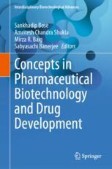Search
Search Results
-
Recognition of Pathogen Attacks by Plant Immune Sensors and Induction of Plant Immune Response
AbstractPlants lack specialized mobile immune cells. Instead of this, each plant cell can recognize an attack of a pathogen and activate an effective...

-
MiStImm: an agent-based simulation tool to study the self-nonself discrimination of the adaptive immune response
BackgroundThere is an increasing need for complex computational models to perform in silico experiments as an adjunct to in vitro and in vivo...

-
Hepatitis B virus evades immune recognition via RNA adenosine deaminase ADAR1-mediated viral RNA editing in hepatocytes
HBV is considered as a “stealth” virus that does not invoke interferon (IFN) responses; however, the mechanisms by which HBV bypasses innate immune...

-
Immune System and Mechanism of Immunomodulation
The immune system and its constituents establish an interface with the environment suitable for distinguishing “self” from “nonself” and then...
-
The Role of RNA Editing in the Immune Response
The innate immune receptors in higher organisms have evolved to detect molecular signatures associated with pathogenic infection and trigger...
-
Role of DAMPs and cell death in autoimmune diseases: the example of multiple sclerosis
Multiple sclerosis is a chronic neuroinflammatory demyelinating disease of the central nervous system (CNS) of unknown etiology and still...

-
Prokaryotic ribosomal RNA stimulates zebrafish embryonic innate immune system
ObjectivesCell-culture studies reported that prokaryotic RNA molecules among the various microbe-associated molecular patterns (MAMPs) were uniquely...

-
Vertebrate Immune Systems
All cellular organisms have some form of immunity from microbial pathogens. The two main forms of immunity are innate and acquired immunity. Innate...
-
Neoself Antigens Presented on MHC Class II Molecules in Autoimmune Diseases
Major histocompatibility complex (MHC) class II molecules play a crucial role in immunity by presenting peptide antigens to helper T cells. Immune...
-
Biological roles of A-to-I editing: implications in innate immunity, cell death, and cancer immunotherapy
Adenosine-to-inosine (A-to-I) editing, a key RNA modification widely found in eukaryotes, is catalyzed by adenosine deaminases acting on RNA (ADARs)....

-

-
How does the immune system learn to distinguish between good and evil? The first definitive studies of T cell central tolerance and positive selection
Demonstration that immature CD4 + 8+ thymocytes contain T cell precursors that are subjected to positive and negative selection was the major step...

-
Development of first linkage map for Silphium integrifolium (Asteraceae) enables identification of sporophytic self-incompatibility locus
Silphium integrifolium ( Asteraceae ) has been identified as a candidate for domestication as a perennial oilseed crop and is assumed to have...

-
Immunoinformatics for the Diagnosis and Monitoring of Autoimmune Diseases
A complicated and diverse set of illnesses known as autoimmune diseases occur when the immune system attacks healthy cells and tissues, causing...
-

-
Redirecting Human Conventional and Regulatory T Cells Using Chimeric Antigen Receptors
The adaptive immune system exhibits exquisite specificity and memory and is involved in virtually every process in the human body. Redirecting...
-
Immunity in Invertebrates, Plants, and Prokaryotes
Vertebrates are not the only organisms with well-developed immune systems. Practically all organisms have some form of innate immunity, and many have...
-
Recent Developments in the Immunotherapeutic Approaches for Cancer Treatment
Cancer is basically a class of disorder marked by uncontrolled proliferation of cells which have the potential to interfere with different systems of...
-
An Agent-Based Model of T Helper Cell Fate Decisions in the Thymus
The recognition of conserved features among pathogens is not sufficient to face all different types of threats that might occur throughout an...
-
A GM-CSF-neuroantigen tolerogenic vaccine elicits inefficient antigen recognition events below the CD40L triggering threshold to expand CD4+ CD25+ FOXP3+ Tregs that inhibit experimental autoimmune encephalomyelitis (EAE)
BackgroundTolerogenic vaccines represent antigen-specific interventions designed to re-establish self-tolerance and thereby alleviate autoimmune...

